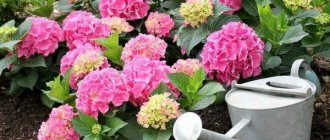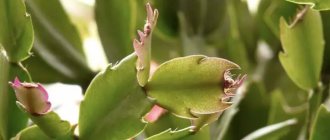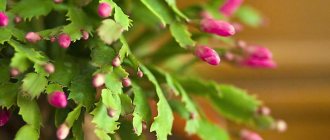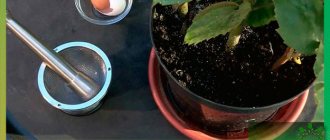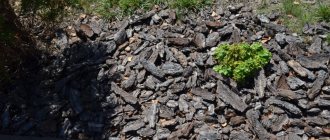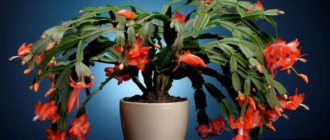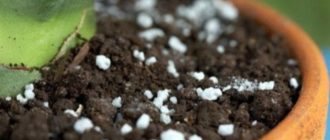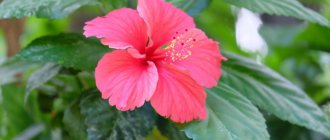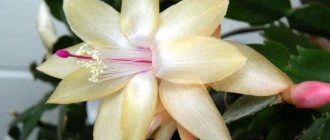Decembrist (schlumbergera or Christmas tree) is a common indoor flower, the buds of which are formed on fresh growths, that is, on the tips of the shoots. To get lush flowering of the plant, it is necessary to stimulate the growth of these shoots with the help of fertilizers. Let's talk about how to feed the Decembrist flower so that it feels good and blooms luxuriously.
How to feed the Decembrist for lush flowering 1.1 Fertilizing the plant with folk remedies 1.2 Mineral supplements for the Decembrist 1.3 Using special preparations 2. What to feed the Decembrist in the fall
Photo by O. Nikonorova: you can achieve lush flowering of the Decembrist plant with the help of fertilizers.
Why do you need to feed a flower at home?
The use of root and foliar fertilizers ensures proper growth and abundant flowering of Schlumbergera. Against the background of a deficiency of nutrients, the speed of flower development slows down and it may die. To stimulate the process of laying flower buds, it is important to promptly fertilize the soil in which the crop grows.
Feeding the Decembrist at home will be required in the following cases:
- Poor flowering or lack of buds on the bushes. In this situation, it is reasonable to stimulate the culture with balanced fertilizers for the Decembrist, which contain phosphorus and potassium.
- Severe shedding of leaf segments. Flower growers recommend applying Decembrist fertilizer directly under the root system, and also spraying the green mass with a solution for epiphytic cacti.
- Transplanting a plant into new soil. Feeding is applied 5 weeks after the procedure.
Banana peel infusion
This fruit contains a lot of potassium, which needs to be fed to the Decembrist in November for the formation of buds and in December during flowering. In addition, bananas contain manganese, phosphorus, sodium and iron.
A solution is prepared from the skins of ripe bananas. Pour 2 skins with a liter of water at room temperature and infuse for 24 hours. During this time, not only minerals, but also organic substances will be released from the banana skin, resulting in a very nutritious infusion. They water the Christmas tree at the root.
What time to apply fertilizer
When determining the timing of fertilizing, it is worth taking into account the period of plant development. It is recommended to apply fertilizers for the Decembrist from the 20th of March to November. In spring and summer, it is advisable to use fertilizers that contain nitrogen. This fertilizer promotes the growth and strengthening of green mass.
How to feed Decembrist for abundant flowering? In the last week of October, you need to add a phosphorus-potassium preparation. Using this fertilizer allows you to achieve lush and long-lasting flowering.
In late autumn, buds begin to form. During this period, you can fertilize the soil in which the flower grows with diluted mullein, chicken or pigeon droppings, or wood ash.
When is the best time to feed Decembrist
The period of active growth in Schlumbergera begins in March. It is from this month in the spring that you need to fertilize. For those who grow plants in a greenhouse, it is advisable to do this weekly; in a city apartment, the Christmas cactus is fertilized a little less often - twice a month.
Before flowering
In spring and summer, the flower actively increases its green mass, so nitrogen fertilizing will be appropriate at this time of year. Fertilizer is applied until the beginning of November, and then a month-long break is taken, giving the Decembrist the opportunity to prepare for flowering. In autumn, it is better to move the flower closer to the glass, or place it on a glassed-in balcony.
Lower temperatures will promote the formation of flower buds. Why does it happen that the Decembrist blooms not in spring, but in late autumn? The fact is that his homeland is in a different hemisphere with opposite seasonality. When spring comes there, autumn comes to us and vice versa.
During bud formation
In November-December, the flower ends its dormant period and begins to form buds. During this period, Schlumbergera requires phosphorus-potassium supplements. Due to this, the buds are “hardened”. The addition of phosphorus and potassium allows the plant to form a large number of flowers.
The Decembrist needs additional nutrition during this period so that the buds do not fall off, but remain in their places and soon turn into beautiful flowers. Initially, in nature, the color of the buds was only white and red. As a result of selection, varieties with lilac, violet, salmon, and yellow flowers appeared. There are also varieties with two-tone colors.
On a note! Some bred hybrids bloom a month earlier than their counterparts.
During flowering
Decembrist blooms once a year and lasts about a month. The plant blooms closer to Christmas according to the old style. Depending on the variety, this period may shift slightly forward or backward. To prevent the Decembrist from blooming too quickly, it is better to maintain the temperature in the range from 15 to 20 degrees. At higher temperatures, flowers dry out faster.
In addition, during this period, Schlumbergera needs regular watering; due to dry soil, the plant may drop its flowers prematurely. However, overmoistening should not be allowed. In nature, Decembrist grows as an epiphytic plant; its roots do not tolerate stagnant water. Adding phosphorus and potassium during this period will prolong flowering and allow the plant to accumulate nutrients for further growth.
How to fertilize Decembrist for growth and flowering
The Christmas tree needs special feeding that is gentle on the root system, therefore, when using ready-made fertilizer for indoor flowers, the concentration should be reduced by 2 times.
But most often, home remedies are used to feed this plant and improve the composition of the soil. For example, you can feed the Christmas tree with aspirin. A crushed aspirin tablet is diluted in 1 liter of water. The resulting solution is used in the fall to moisten the soil.
Below we will tell you how to feed the Decembrist flower at home.
Boric acid
The recommended concentration of the product for spraying green mass is 0.1%. Using Decembrist fertilizer allows you to stimulate shoot growth. In addition, the use of boric acid helps to increase the number of buds. The plant is sprayed twice - during budding and during flowering.
Wood ash
Wood ash can be dissolved in water or added to the soil in dry form. To prepare the solution at home, dissolve 4 tbsp in 2 liters of water. l. wood ash. The components are mixed and infused for 4 hours. Potassium fertilizer for Decembrist is used during the budding period and in the first week of flowering.
Sugar
Glucose is a source of energy and building material for plant cells. For better absorption of sugar fertilizer, it is recommended to apply it to the soil together with the Baikal M preparation. If you ignore this advice, the added sugar will cause mold to appear in the soil.
To prepare the solution, you will need to dissolve 4 tbsp in 2 liters of water. l. Sahara. It is necessary to feed the plant every month, except for the dormant period.
Bred mullein
Many flower growers are interested in what to fertilize the Decembrist plant so that it blooms? Experts recommend adding diluted mullein, pigeon or chicken droppings to the soil. Preparing the solution is quite simple. Mix 200 g of mullein or dung in 1 liter of water. Water the plant generously with the resulting liquid.
Hydrogen peroxide
By saturating the soil with oxygen, you can strengthen the root system and achieve long and lush flowering. To prepare the fertilizer, dilute 2 tbsp in 2 liters of water. l. hydrogen peroxide. The resulting solution is applied under the root system of the Decembrist every 10 days from April to November.
Apple infusion
To prepare an apple infusion for feeding the Decembrist, you need to cut several fresh sour apples into small slices and add water. The liquid is infused for 48 hours, after which it is used to water flowers from March to November.
Brewed tea
Using brewed tea allows you not only to increase the number of buds on Schlumbergera bushes, but also to achieve flowering even for those plants that have refused to bloom for many years. Preparing fertilizer is not difficult. You will need to brew black tea with boiling water and let it steep for about 60 minutes. After the specified period of time, you can use Decembrist fertilizer for flowering for watering (1-2 times a week).
Boric acid
Boron, which is part of boric acid, is very beneficial for plants. With its deficiency, the leaves become small and ovaries do not form. Therefore, boric acid is ideal for stimulating the formation of buds.
Dilute a nutrient solution from 10 g of powder (as much as in a bag) and 10 liters of water. But for one or even several colors this will be too much. For one time, it is enough to dilute boric acid in 1 liter of water on the tip of a knife - this is approximately 1 gram.
You will be interested to know: Whey for plants: how to use, protect and feed tomatoes, cucumbers and other plants with whey
It is important! Boric acid will not dissolve in cold water. First, dissolve the powder in a small amount of warm water, and then bring it to the desired volume. You need to stir thoroughly.
The resulting nutrient solution is sprayed onto the leaves. Use foliar fertilizing with boric acid no more than 2 times per season. It is recommended to feed the Decembrist plant with boric acid in November so that buds form on it by December.
Signs of improper feeding
When deciding to feed the Christmas tree, you should take into account the needs of the plant in order to choose the right product and dosage. The following signs indicate improper feeding of the Decembrist:
- the appearance of yellow spots on leaf blades - most often such a nuisance occurs against the background of an excess of phosphorus;
- leaf burns, death of green mass, which signals excess boron;
- the absence of flowering indicates a supersaturation of the soil with nitrogen.

